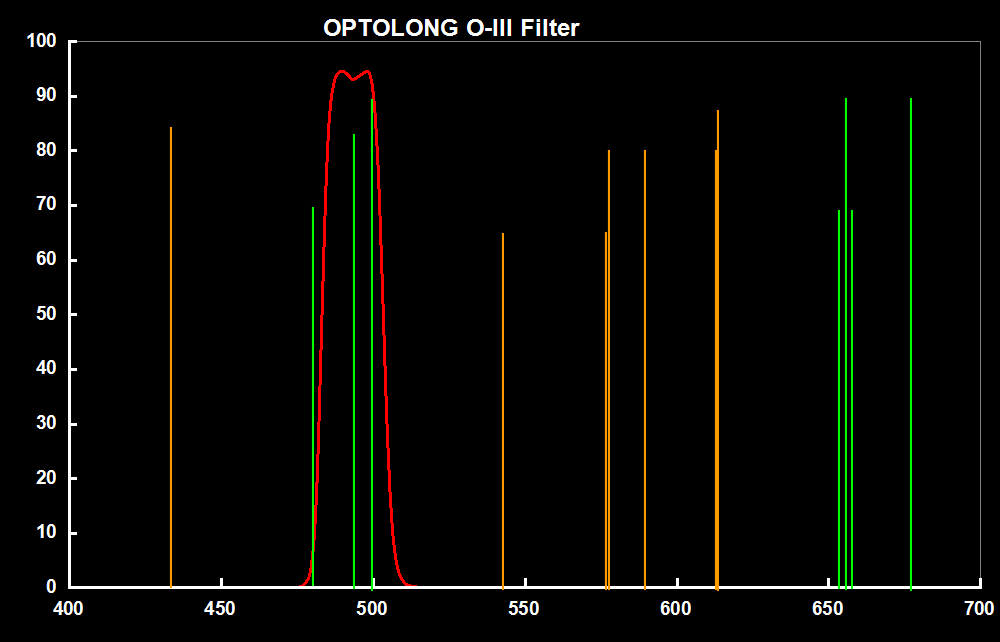About this product
Model: opt_oiii_18nm_1.25
Narrowband OIII 18nm Light Pollution Filter - Ideal for Nebula Observation
The Optolong narrowband OIII filter is designed for nebula observation allowing 18nm bandwidth of light centered on a wavelength of 500nm through, which corresponds to OIII emission lines, and reducing the transmission of certain wavelengths of light, specifically those produced by artificial light including mercury vapour, and both high and low pressure sodium vapour lights and the unwanted natural light caused by neutral oxygen emission in our atmosphere (i.e. skyglow).
OIII emits 495.9nm and 500.7nm and it is a blue-green coloured filter. Many images of planetary nebula and supernova remnants are taken only with H-alpha and OIII filters. They show great structural details, but have natural colours, looking like an RGB image.
IMPORTANT: Filters manufactured by Optolong are NOT designed for observing or photographing the Sun. DO NOT use Optolong filters to observe or photograph the Sun. If you do it will result in permanent eye damage!
FEATURES
- 90% transmission at major OIII line 495.9nm and 500.7nm.
- 0.1% transmission of off-band, specifically the major emission lines of artificial light pollution (i.e. Na 589nm, Hg 435nm and 578nm)
- Suitable for visual observations on most emission nebulae, planetary nebulae and supernova remnants
- 1.25" or 2" Mounted Sizes.
- Supplied in a protective plastic case with EVA foam lining
- 2mm (1.25" / 2") Thick Schott Glass
- Fine-optically polished on both sides - ensures accurate λ/4 wavefront and <30 seconds parallelism over the both surfaces
Transmission Chart

Please note - this graph is for the older generation which had a 25nm bandwidth. This updated 18nm version has a tighter bandpass area.
Red Line - Represents the transmission curve of the OIII Filter.
Green Line - The Major Emission Lines of Nebulae: H-α (656.3nm), H-β (486.1nm), OIII (495.9nm) and OIII (500.7nm)
Orange Line - The Major Emission Lines of Artificial Light Pollution: Hg / Mercury (435.8nm, 546.1nm, 577nm and 578.1nm), Na / Sodium (598nm, 589.6nm, 615.4nm and 616.1nm)
Technical Data
- Schott substrate material
- Thickness 2.0 mm (1.25”/2”/36mm)
- Thickness 1.0 mm (Clip series)
- Surface Quality: 60/40 (Refer to MIL-O-13830)
- Fine-optically polished to ensure accurate 1/4 wavefront and <30 seconds parallelism over the both surfaces
- 95% transmission of main nebula emission lines (i.e. H-alpha 656nm, OIII 496nm and 500nm, SII 672nm and H-beta 486nm
- 0.1% transmission of off-band, specifically the major emission lines of artificial light pollution (i.e. Na 589nm, Hg 435nm and 578nm). Transmission of 0.1% is equivalent to OD3 (Optical Density), and a high optical density value indicates very low transmission, and low optical density indicates high transmission.
Coating Parameter
- Multi-layers anti-reflection coating
- Non-cementing optical substrate coating
- Electron-beam gun evaporation with Ion-assisted deposition coating technology for durability and resistance to scratching, as well as stability on CWL (central wavelength) no deviation affected by temperature change
- Planetary rotation system offers precision and homogeneity of coatings ensuring high value on transmission of pass-band and Optical density of off-band
Filter Cell
- Ultra-thin filter cell minimise vignetting by maximise possible clear aperture (clear aperture is 26mm for 1.25”; 45mm for 2”)
- Aerometal Material | Precise CNC Machining | Sand Blasting Process | Black Anodised Finish | Extinction Treatment to Prevent Reflection | Laser Engraving No Fading
Customer reviews
| Average Rating (1 Review): | |
22 October 2019 | George
The filter is in a well protective case, but haven't had a chance to test it out, due to weather.
FAQ
Please fill in the form below to ask a question.